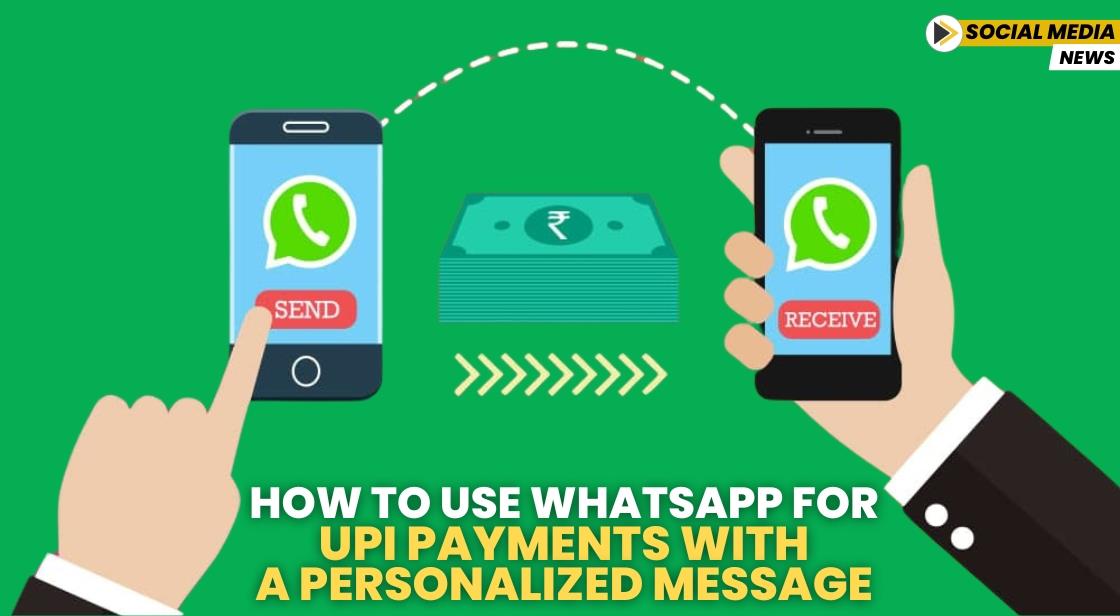How to Use WhatsApp for UPI Payments with a Personalized Message

News Synopsis
WhatsApp, one of the most widely used messaging platforms globally, offers a convenient feature in India: the ability to send and receive payments via UPI (Unified Payments Interface). This service is integrated directly within the app, making digital transactions as simple as sending a text message. With the growing adoption of digital payments, WhatsApp's UPI feature provides a seamless experience for users, complementing other UPI payment apps like BHIM, Google Pay, and PhonePe.
The introduction of UPI payments on WhatsApp has revolutionized peer-to-peer money transfers, offering a faster, more accessible, and user-friendly method for making payments. Whether for splitting bills, paying for services, or sending money to friends and family, WhatsApp Payments makes it easier than ever to handle financial transactions. Additionally, this feature has the potential to significantly enhance the digital economy in India by facilitating micropayments and increasing the efficiency of mobile transactions.
If you're ready to start using WhatsApp for UPI payments, follow these steps for a smooth setup and easy transactions.
Step-by-Step Guide to Setting Up UPI Payments on WhatsApp
Step 1: Update WhatsApp to the Latest Version
To begin, ensure that you have the latest version of WhatsApp installed on your device. Head over to the Google Play Store if you're using an Android device, or the Apple App Store if you're on iOS, and update the app to the most recent version. This ensures you have access to the latest features, including UPI payments.
Step 2: Link Your Bank Account to UPI
If you haven’t already linked your bank account to a UPI platform, you’ll need to do this before setting up WhatsApp Payments. You can link your account through any UPI-enabled app, such as BHIM, Google Pay, or PhonePe. Make sure that the information provided, including your mobile number and bank details, matches across all platforms to avoid any issues.
Once your bank account is linked to UPI, you’ll be able to use WhatsApp for payments seamlessly. It’s important that the mobile number registered with your bank is the same as the one used for your WhatsApp account.
Step 3: Access WhatsApp Payments Settings
Now that your UPI account is set up, open WhatsApp on your Android or iOS device. Navigate to the app’s Settings by tapping the three vertical dots in the top-right corner of the screen. From the settings menu, select Payments, then click on Add Payment Method.
At this point, you’ll need to accept WhatsApp’s terms and conditions by tapping Accept & Continue. This will initiate the process of adding a UPI payment method to your account.
Step 4: Select Your Preferred UPI App
Once you’ve started the setup process, WhatsApp will scan your device for any UPI-enabled apps that are already installed, such as Google Pay or PhonePe. You’ll see a list of these apps, and you’ll be prompted to choose your preferred payment app.
After selecting your preferred app, WhatsApp will automatically initiate a collect request to link your bank account. You will need to enter your UPI PIN to verify and complete the setup.
Step 5: Connect Your Bank Account with WhatsApp
Once your UPI account is verified, your bank account will be successfully linked to WhatsApp Payments. This allows you to send and receive money directly from your WhatsApp account without the need for third-party apps.
Step 6: Sending Money via WhatsApp
To send money, open the chat window of the contact you wish to transfer money to. Tap the Attachment Icon (usually represented by a paperclip or plus symbol), and select Payment from the menu. You’ll be prompted to enter the amount you wish to send, as well as any payment details or notes.
Once you’ve reviewed the payment details, press Send to complete the transaction. The money will be transferred instantly, and you’ll receive a confirmation message once the payment has been processed.
Step 7: Receiving Money via WhatsApp
Receiving payments on WhatsApp is just as straightforward. The person sending you money will need either your registered UPI ID or can scan the QR Code found within the Payment Options in WhatsApp.
To share your UPI ID or QR code, navigate to the Payment section in your WhatsApp settings and select the option to display or share your QR code. The sender will then verify the transaction and initiate the payment. Once the payment is sent, you will receive a notification confirming the amount and details of the transfer.
Advantages of Using WhatsApp for UPI Payments
Using WhatsApp for UPI payments offers several advantages. Firstly, it’s incredibly convenient. Since most users are already active on WhatsApp, integrating payments into the platform simplifies the process of sending and receiving money. There’s no need to switch between different apps, making the user experience seamless and efficient.
Secondly, WhatsApp Payments is safe and secure. It uses the same UPI infrastructure as other payment apps, ensuring that transactions are encrypted and protected by UPI PIN verification. This provides users with confidence in the security of their financial data.
Finally, WhatsApp Payments has the potential to boost India’s digital economy. By making it easier for people to conduct mobile transactions, especially for smaller amounts, it can accelerate the adoption of digital payments across the country. This can drive new consumption habits and help small businesses and individuals benefit from the convenience of mobile transactions.
Conclusion
With the introduction of UPI payments on WhatsApp, transferring money has never been easier. By following the steps outlined above, you can quickly set up your WhatsApp Payments account and start sending or receiving money just as easily as you send a message. WhatsApp’s integration with UPI is a game-changer for India’s digital payment landscape, offering convenience, security, and scalability.
As WhatsApp Payments continues to evolve, it will undoubtedly play a significant role in shaping the future of peer-to-peer payments and the overall growth of the digital economy in India.
You May Like









